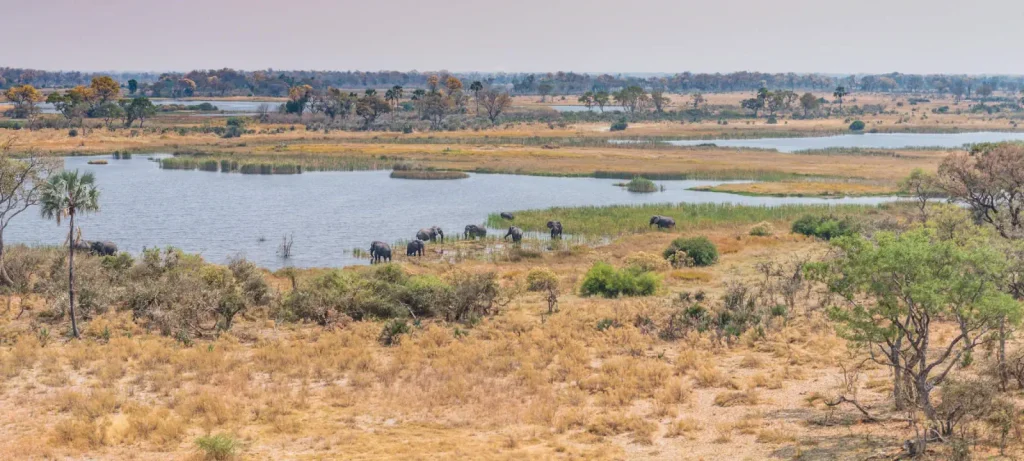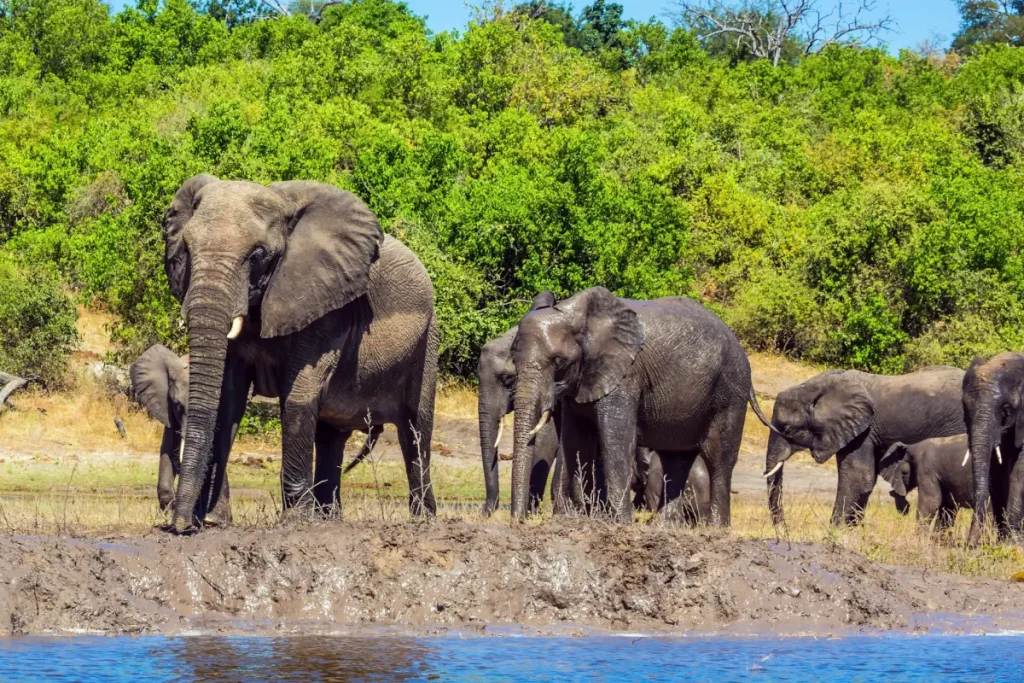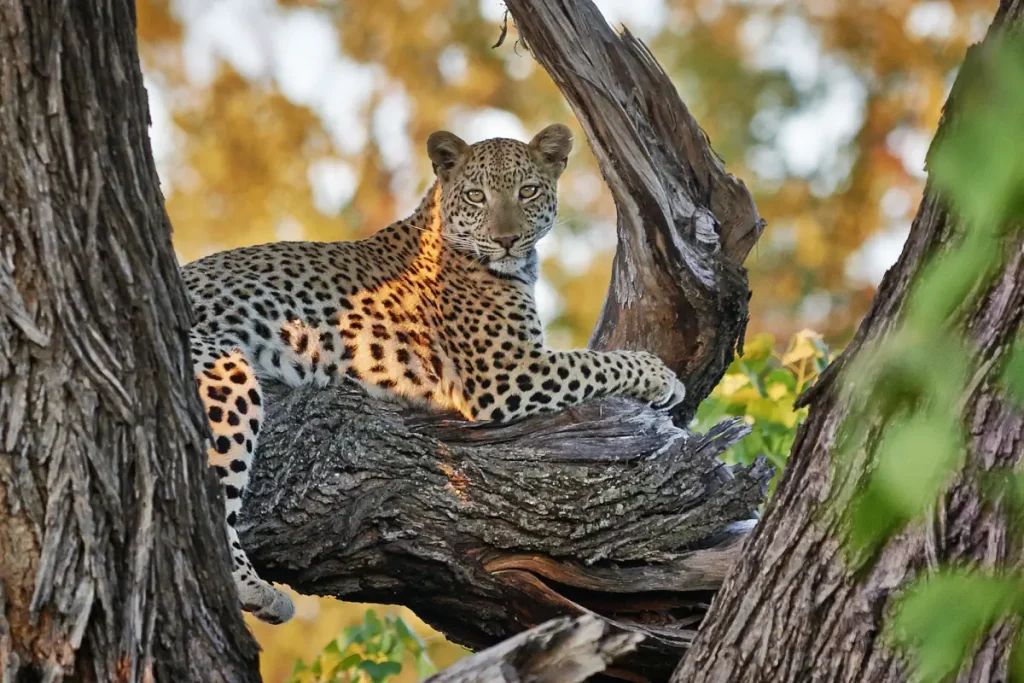The Okavango Delta is a unique pulsing wetland where the 1,600 km (990 mi) long Okavango River reaches a tectonic trough in the middle of the Kalahari Desert in northern Botswana. Each year approximately 11 cubic kilometers of water spread over the 6,000-37,500 km2 area. It is on the UNESCO World Heritage List as well as one of the Seven Natural Wonders of Africa (see notes 1).
Geography of the Okavango Delta
Formation of the Okavango Delta
The Okavango Delta is an unusual marvel of nature. Unlike most river deltas, it doesn’t flow into the sea but instead seeps into the Kalahari Desert, creating a vast, 18,000 sq km oasis, teeming with African wildlife.
This delta is essentially an alluvial fan, characterized by areas that experience permanent, seasonal, or occasional flooding. Its seasonal transitions give rise to the lush and diverse habitat, making it an ecological hotspot.

Origin of the Okavango River
Originating from the Planalto highlands of Angola, the Okavango River’s journey spans 1,100 km. Small tributaries form the Cuito River, which later merges with the Cubango River, becoming the broader and mightier Okavango River by the time it reaches Botswana.
Determinants of the Delta’s Flow and Shape
The Okavango’s flow and topography are shaped by a blend of natural physical and biological factors. Ancient channels in the Kalahari sands, sedimentation, and tectonic activity contribute to its physical structure. Concurrently, biological processes, such as hippos creating water paths and termites building mounds, also play a role. Given the interplay of these myriad elements, the water’s flow remains ever-changing.
Geological Past
Historically, the central Kalahari once housed Lake Makgadikgadi. Now, the only remnants are the Okavango Delta and the expansive Makgadikgadi salt pans. Geological experts hypothesize that the Kwando, Linyanti, Chobe, and Upper Zambezi were once part of a singular massive river.
Tectonic activities from the Great East African Rift Valley played a pivotal role in the delta’s formation about two million years ago. These tectonic shifts created fault lines which impacted the water’s flow, giving rise to the sprawling wetlands of the Delta and Linyanti.
A Unique Freshwater System
What sets the Okavango apart is its freshwater nature. Typically, interior drainage systems become saline due to evaporation. But outlets like Lake Ngami and the Boteti River help retain the delta’s freshwater character.
Each year, the Okavango River discharges approximately 11 cubic kilometers (1.1 × 1013 liters) of water into the delta. Most of this water is lost to transpiration by plants (60%) and by evaporation (36%) with only 2% percolating into the aquifer system with the remainder finally flowing into Lake Ngami.

Factors Shaping the Delta
The Delta’s form owes its genesis to the geological shifts and sediment deposits. The Okavango River has, over millennia, deposited massive amounts of sediment, which plays a central role in determining the Delta’s ever-changing morphology. Additionally, the persistent activity of animals like hippos and the growth of flora like papyrus continually modify its waterways.
Island Formation
The Delta is home to diverse islands, each telling its unique story. There are long islands formed by sediment buildup, round islands initiated by termite mounds, and vast islands like Chief’s Island, birthed by tectonic shifts. These islands are not just geographical landmarks but vital ecosystems supporting a plethora of wildlife.
Delta’s Age and Historical Shifts
The current Okavango Delta, as defined by the Thamalakane fault, might only be around 120,000 years old. Past sediment deposits suggest that the Delta’s waters once flowed well beyond its current boundaries. Over the past million years, the Delta has undergone cycles of drought and flooding, sometimes appearing as a vast desert, and at other times, as expansive lakes.
The water flows continuously into the delta and drains the summer (January to February) rainfall from the Angolan highlands. A surge, that flows 1200 kilometers in a month occurs between March and June. It is during this time that the Okavango Delta is at its largest, its area is almost 250 km to 150 km.
Generally flat, with a height variation of fewer than two meters across its area (6 feet and 6 inches), dry land in the delta is predominantly comprised of numerous small islands, formed when vegetation takes root on termite mounds. “Chief’s Island” the largest island in the delta, was formed by a fault line that uplifted an area over 70 km long and 15 km wide. Historically it was reserved as an exclusive hunting area for the chief. It now provides the core area for much of the resident wildlife when the waters rise.
The Okavango Delta is an important wildlife area and it was included on UNESCO’s World Heritage List in 2014, as the 1000th site on the list.
Wildlife in the Okavango Delta

Nestled within the heart of the Kalahari, the Okavango Delta stands as a haven of biodiversity, thanks to its intricate ecosystems and dedicated conservation efforts. This lush wetland supports a staggering array of fauna, both seasonally and year-round, making it a veritable heaven for wildlife enthusiasts.
The delta’s vibrant wildlife patterns change with the seasons. During the rains, vast numbers of larger fauna move away, lured by the verdant expanses encircling the delta. Yet, as the green sheen fades with the winter chill, they are drawn back to the delta’s embrace.
The Okavango Delta is one of the best places to see animals and birds in Africa. The area supports large concentrations of animals on both a permanent and seasonal basis.
A number of species can be found within the delta including Lion, African Bush Elephant, African Buffalo, Hippopotamus, Leopard, Lechwe, Topi, Blue Wildebeest, Giraffe, Nile crocodile, Cheetah, Brown Hyena, Spotted Hyena, Greater Kudu, Sable Antelope, Black Rhinoceros, White Rhinoceros, Plains Zebra, Warthog, and Chacma Baboon.
Notably, the endangered African Wild Dog still survives within the Okavango Delta and exhibits one of the richest pack densities in Africa.
But it’s not just the land-dwelling species that captivate. In addition to these large animals, the Okavango Delta’s skies are painted with over 500 bird species, each lending its unique hue to this vast canvas.
Its waters are also home to 85 distinct fish species, it’s a realm where the fierce Tigerfish swims alongside the gentle Tilapia and the mighty Catfish.
Thanks to this wide variety of wildlife, the delta is now a popular tourist attraction.

Climate
Okavango Delta is very green, but it’s not the result of a wet climate. The average annual rainfall is 450 mm.
In the summer, December to February is a hot wet time span with daytime temperatures as high as 40°C, warm nights, and humidity levels fluctuating between 50% and 80%.
During the autumn, from March to May, the temperature becomes far more comfortable with a maximum of 30°C during the day and mild to cool nights. The rains quickly dry up leading into the dry, cold winter months of June to August. Daytime temperatures at this time of year are mild to warm, but the temperature begins to fall after sunset.
Nights can be surprisingly cold in the Delta, with temperatures barely above freezing.
The spring, from September to November sees the heat and atmospheric pressure build up once more as the dry season slides into the rainy season. October is the most challenging month for visitors – daytime temperatures often push past 40°C and the dryness is only occasionally broken by a sudden cloudburst.
People
Very few people live in the wetlands of the delta, with most living in towns and villages on the outskirts. The first official census of Ngamiland (North-West District of Botswana), derived by assembling and counting people at their headman’s village, revealed a population of 21,550 in 1904. This method was used again in 1911, 1921, and 1936.
In the modern era, the population has risen dramatically since the first modern census of 1964 from 42,572 people then to 138,654 people in 2006.
Possible Threats to Okavango Delta
The Namibian government has presented plans to build a hydropower station in the Zambezi Region, which would regulate the Okavango’s flow to some extent. While proponents argue that the effect would be minimal, environmentalists argue that this project could destroy most of the rich animal and plant life in the Delta. Other threats include local human encroachment and regional extraction of water in both Angola and Namibia.
The award-winning South African filmmaker and conservationist Rick Lomba (1950-1994) warned in the 1980s of the threat of cattle invasion to the area. His 1986 environmental documentary The End of Eden vividly portrays this and his lobbying on behalf of the Delta helped to preserve its integrity.
Video: Botswana’s Okavango Delta – The Heaven on Earth
Notes
- Seven Natural Wonders of Africa (the natural wonders on the list below were selected by voting on February 11, 2013):
- Red Sea Reef (Coast of Egypt, Eritrea, and Sudan)
- Mount Kilimanjaro (Tanzania)
- Sahara Desert (Algeria, Chad, Egypt, Libya, Mali, Mauritania, Morocco, Niger, Sudan, Tunisia, Western Sahara)
- Serengeti Migration (Tanzania and Kenya)
- Ngorongoro Crater (Tanzania)
- Nile River (Ethiopia, Sudan, Egypt, Uganda, the Democratic Republic of the Congo, Kenya, Tanzania, Rwanda, Burundi, South Sudan, Eritrea)
- Okavango Delta (Botswana)
Sources
- Okavango Delta on Wikipedia
- Okavango Delta’s official website
- The End of Eden on Wikipedia
- African Wild Dog Conversation Status [Endangered] on the International Union for Conservation of Nature (IUCN) Red List of Threatened Species website
- How Many Elephants are Left in the World in 2025? - August 17, 2025
- Moon Landings: All-Time List [1966-2025] - February 2, 2025
- What Is Max-Q and Why Is It Important During Rocket Launches? - January 16, 2025
